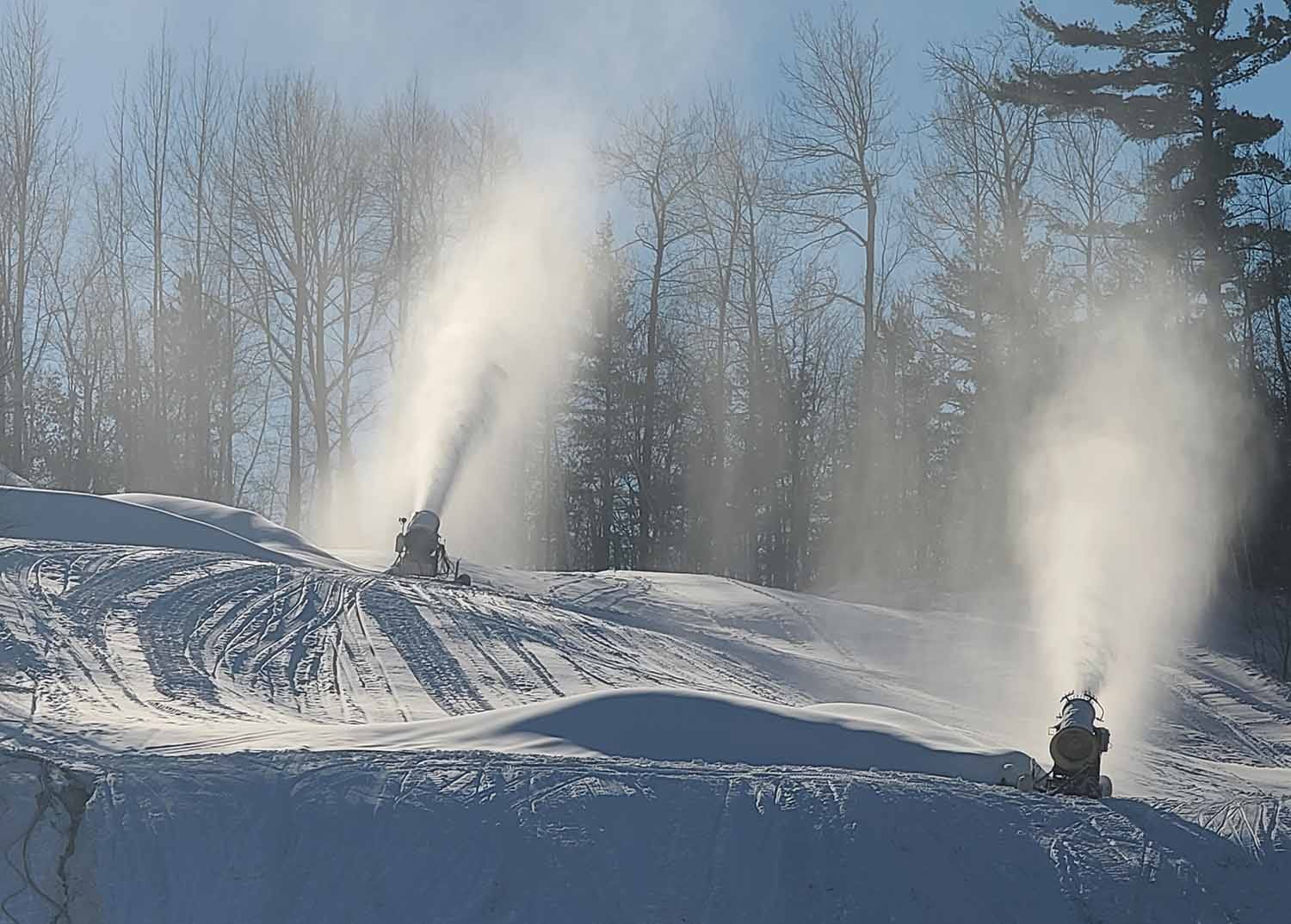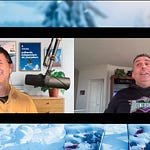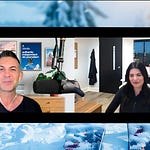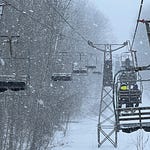Who
TJ and Wendy Kerscher, Owners of Paul Bunyan Ski Hill, Wisconsin
Recorded on
May 23, 2022
About Paul Bunyan
Owned by: TJ and Wendy Kerscher
Located in: Lakewood, Wisconsin
Closest neighboring ski areas: Keyes Peak, Wisconsin (1 hours); Ski Brule, Michigan (1.25 hours); Camp 10, Wisconsin (1.25 hours); Granite Peak, Wisconsin (1.5 hours); Pine Mountain, Michigan (1.5 hours)
Vertical drop: 150 feet
Average annual snowfall: 65 inches
Trail count: 6 (2 black, 2 intermediate, 2 beginner)
Lift count: 3 (1 T-bar, 2 ropetows - view Lift Blog’s of inventory of Paul Bunyan’s lift fleet)
Trailmap: Paul Bunyan has yet to create an updated trailmap. This overhead-oriented version created by skimap.com is the closest thing I could find, though TJ told me that the ropetow and tubing park - and associated trails - looker’s left on this map have not yet re-opened (he hopes to have them ready for the 2022-23 ski season, along with a top-to-bottom ropetow that runs parallel to the T-bar):

This map, from 1993, shows the state of the ski area just before it closed, in 1995:

This map, from 1980, is probably my favorite from an aesthetic point of view:

Why I interviewed them
In 2016, a California businessman named Jeff Katofsky purchased the long-dormant Sugar Loaf ski area in northern Michigan. A real estate developer and minor league baseball team owner, he seemed to barely understand skiing, declaring shortly after taking possession of the property that he had visited Whistler “to get ideas.” Which is like visiting the Palace of Versailles to get ideas on how to decorate your hunting cabin. The next year, he stripped all five Hall* doubles from the hillside. “The ski hill presently has to basically be gutted because nothing on there can work,” he told the Glen Arbor Sun. “Whether we can put another ski hill together or not, we’re crunching a lot of numbers together to see if that works.”
The Crunchinator came up with some pretty intense numbers. For Katofsky, skiing was a high-end pursuit, which could only be provided in an ultra-luxurious context. “Skiing is purely a financial question,” Katofsky told the Sun in 2018. “I have to take it seriously because I know it’s important to people. But I’m not doing this for charity. We’ll invest literally tens of millions of dollars in this. If skiing works financially, you’ll have it. If not, you won’t.”
Skiing must not have worked financially. In December 2020, Katofsky sold the property to an anonymous buyer and disappeared, without comment, into the void.
Katofsky, to be fair, was not trying to spend tens of millions of dollars to resuscitate a ski resort, explicitly. He intended to spend tens of millions to build a year-round spa-and-valet sort of place that had a little ski hill as an addendum. Something like Villa Roma in New York’s Catskills, which offers a minimalist ski experience but long ago mothballed an entire terrain pod.
That’s a shame. Sugar Loaf was once one of the best ski areas in Michigan’s Lower Peninsula, a nationally unsung ski mecca as nuts about this stupid snoskiing thing as anyplace that’s cold and remotely hilly. The front side was 500 feet of pure fall line, the backside woods and narrow lanes. The summit view was gorgeous. The vibe pure zest and zeal. No pretention here. The place was fabulous, as good as Boyne Mountain from a pure skiing point of view. I couldn’t believe it when the hill closed in 2000.
I’m still miffed. I’m not alone: the 5,015-member Friends of Sugar Loaf Facebook group is an online watering hole for the nostalgic and the hopeful (though IT’S NOT HAPPENING Bro is an unfortunate omnipresent parasite as well). I tend to be It Could Happen Bro, certain that a minimalist version of skiing could be viable. Last year, I exchanged emails with Traverse City native, former Sugar Loaf ski patroller, and Waterville Valley general manager Tim Smith about the possibility of a minimalist version of Sugar Loaf resurfacing at some point:
Stuart: I'm really curious about your point of view on Sugarloaf, since you've been in skiing so long and really understand what it takes to bring a mountain back to life, and you seem to have a knack for making things happen. How much would it take to bring a minimum level of skiing back to Sugarloaf? Like let's say you sent [Waterville Valley’s retiring] Sunnyside Triple there and strung it base to summit up Awful Awful and brought in some mobile snow guns - would that be enough? I'm probably over-simplifying it, but I feel like the current owner has it in his head that skiing needs to be uber luxurious before you sell a lift ticket. But you look at Mount Bohemia in the UP, and the guy basically opened the place with some yurts, a base lodge, and a lift.
Tim: Your simplification is pretty spot on. Minimum infrastructure to get going again would be a new/used lift, say $2 million will cover that with installation. For snowmaking pipe/pond/pumps/electrical for the frontside (Round About, Nastar, Waful, k2 and Awful Awful) 25 acres or so (that’s twice the size of Waterville Valley’s high country) feed that with 2,000 gpm giving an acre foot of snow every 1.33 hours, so 33 hours at full blast to cover the area with a foot of snow. To blast that type of snow the area would need at least 20 guns but I would recommend 40 as maxing out requires extreme cold. That’s 500k in guns, 500k in pumping, $1.5M for pipe, hydrants, electrical (bit of a WAG as I don’t know what is still there for primary electrical). A steel building lodge like Crotched runs about $2.5 but a yurt village would be doable for a few 100k so let say $1M for now. Parking is still in OK shape but I think the thing that would kill the project is the demo of the old lodge, but the county or state may help as it is a public nuisance at this point, so let’s say the fire department does a controlled burn 🔥 All said and done on a shoe string $5M should get it up and running. But if it was me I would go all in as I think the area could support a higher end resort, just need the right money man 😎. This is off the top of my head, some day it would be fun to run these numbers down and see if something could really work.
OK, aren’t we here to talk about Paul Bunyan? Indeed. Excuse the detour, but I had a point: In about nine months in 2020, TJ and Wendy Kerscher and their family accomplished what gazillionaire Katofsky couldn’t in four years. In the midst of the early Covid lockdowns, their bar and their figurine factory idled, the Kerschers looked out at the overgrown and long-abandoned ski hill in their backyard and got to work. TJ meticulously dismantled and reassembled the 1967 Hall T-bar and several ropetows that had been A-Teamed together from 1940s truck parts. With crews of chainsaw-wielding friends, they marched up the hillside and cleared 25 years of forest. They borrowed snowguns from idled Norway Mountain, Michigan; picked up a trio of used Snowcats from Granite Peak; worked with K2 to build a small fleet of rental gear. In February 2021, the ski area re-opened to ecstatic locals.
“They filled this place,” Wendy Kerscher told me in the interview. “They filled the hill. We ran out of rentals. It was amazing.”
The Katofskys and IT’S NOT HAPPENING Bros of the world would have taken one look at Paul Bunyan and came up with a thousand reasons why the place was inoperable. Too decrepit, too small, too remote, too tired, too knotted to a bygone era of skiing, when surface lifts and five turns top-to-bottom were good enough.
I have little use for such people. The cynics and the you-can’ts, the ones who always tell you why not. I am searching for the TJ and Wendy Kerschers of the world, the optimists and the puzzle-solvers, the people who are too busy working to realize that what they’re doing is impossible.
The way they did what no one else could do was to simply do it. No master plans. No consultants. No expensive crews. No engineers. Just chainsaws and shovels and some borrowed heavy equipment. A little assistance from the ski industry. It helped that TJ had enough mechanical acuity to rebuild the lifts himself. It was a lot of work, but the result was a ski hill summoned out of the grave by Midwest FTW grit-and-grind.
“You never can count sweat equity,” TJ told me. “It was awesome. I would do it all over again five times. I don’t count the work at all. We just had so much fun with this project.”
It’s too bad the Kerschers didn’t live in front of Sugar Loaf. Were the mountain’s Hall lifts – famously reliable machines – really beyond repair? Could a more restlessly optimistic soul like TJ have saved them? Someone who truly loved and understood skiing? I tend to think the answer is yes. And we’ve got a story to prove it, a ski area saved, improbably but truly: Paul Bunyan is back.
*Props to Lift Blog for ID’ing these lifts for me.
What we talked about
The Kerscher family story; the family’s various businesses; the origins of Paul Bunyan as a local nonprofit; when and why the Kerscher family purchased the hill; growing up in an entrepreneurial family; how you react when your father buys a ski area; running a mountain at age 18; why Paul Bunyan closed in the mid-90s; deciding to re-open the ski area after 25 years dormant; a silver lining in Covid; the state of Paul Bunyan’s lifts, trails, and snowmaking after two and a half decades idle; improvisational snowmaking and long-term plans for improvement; that DIY Midwestern grit; restoring the fantastic homemade ropetow network cobbled together with 1940s truck parts; restoring a 1960s Hall T-bar; a fortuitous call from a friendly neighboring ski area; which of the four classic ropetows have been brought back into service, and which are next; the status of the tubing operation; reviving the overgrown trail network – “we got some guys together with some chainsaws and started cutting”; where the ski area is adding runs this summer; options for the forthcoming terrain park; skiers are “really embracing” Paul Bunyan’s “old-school … hang-on-tight ropetows”; restoring the hill’s 1969 Tucker Sno-Cat and why those machines still beat modern groomers for certain tasks; the large ski area that helped Paul Bunyan modernize its grooming fleet with a deal on used machines; setting up a rental shop, ski school, and patrol from scratch; managing labor as a small ski area; insurance; approaching such a massive project day-by-day; how it felt to see the lifts spinning again; “every single weekend, we are sold out of ski equipment”; bringing back night skiing; whether Paul Bunyan could ever be a seven-day-per-week operation; optimism and attitude are everything; advice for aspiring saviors of lost ski areas; the generosity of the greater ski industry; and whether Paul Bunyan had considered the Indy Pass Allied Resorts program.

Why I thought that now was a good time for this interview
I spend a lot of time shuffling through skiing’s online fringe. I am obsessed, for whatever reason, with completeness. This most obviously manifests itself through the Pass Tracker 5001, where I’ve been tracking U.S. America’s season pass prices for the past couple years. For hundreds of resorts, tracking down these numbers is a fairly simple exercise. Northstar – Epic Pass. Mammoth – Ikon Pass. And so on. But perhaps a quarter of the nation’s ski areas exist in a sort of steampunk half-world, online but without a formal website, a Facebook page usually, pointing skiers in a choppy, inconstant way toward their little hills, typically a neighborhood bump with a collection of Rube Goldberg surface lifts trundling up a few acres of clear-cut.
I’ll frequently message these pages with queries about hours of operation or season pass prices. They almost never write back. So I was fairly surprised last month when a query to Paul Bunyan’s account produced a coherent response within hours. We exchanged a few messages and I invited them onto the podcast. So here we are.
Believe it or not, it is typically more difficult to secure an interview with the operators of the Paul Bunyans of the world than the Steamboats or Beaver Creeks. The large ski areas have budgets, communications teams, marketing departments. The executives have talking points and media training. They expect me to knock on the door, and they’re usually willing to talk when I do. With the smaller places, it’s often difficult to determine who owns or manages the hill, and there’s rarely an obvious way to connect with them.
So when I had the opportunity to talk to a family who had the audacity to say, “yeah we’re just going to re-open this ski hill with 60-year-old lifts on a minimal budget and by the way if you think this is impossible we’re just going to ignore you,” I couldn’t book it fast enough.
Part of what makes skiing great is the raw adventure of a four-thousand-footer sprawling across a half dozen peaks with 35 lifts driving up and over cliffs and trees and elevator-shaft inclines. But a big part of what makes it interesting is that it’s not just that. That a network of hundreds of small-bore versions of this gigantic thing exist anywhere that cold weather and hills collide. If The Storm is after the full story of lift-served skiing, it must be not only aware of the world outside the Epkon flex palace, but immersed in it. There’s no better way to do that – and to bring you along with me – than to connect with operators like the Kerschers, whose story is one of pure love and passion, the one-turn-at-a-time kind of fun that so many in skiing have forgotten.
Why you should ski Paul Bunyan
If you live anywhere nearby, the answer to this question is obvious: because it’s there. In-between turns when you can’t make the drive over to Granite Peak. Because skiing can be your wintertime gym. Dip in, get your reps on, bounce. Don’t overthink it.
For the rest of us – I live 1,100 miles away – the answer is more complicated. I acknowledge that only a handful of the most curious outsiders will ever deliberately visit the Midwest to ski. The ski media has ignored this region for its entire existence, focusing instead on two themes that invariably lead skiers north to New England or west to the Rockies: the ultra-rad or the ultra-luxe. Understandable. However, there exists a third narrative in skiing: discovery. I’ve spent the past two ski seasons in a state of perpetual ramble, bouncing from neighborhood bump to backwoods freeride to ridgeline 500-footer lodged at the top of America. It’s fun. You find little stashes, quirks, thrills. I almost never find crowds. Lift-served skiing is an impossibly rich world, dynamic and varied, funky and weird, curious and fascinating.
Someday, I will roll through Wisconsin, and I’ll of course ski Cascade and Devil’s Head and La Crosse and Granite Peak and Whitecap. But I’ll also float through Paul Bunyan, ride the old T-bar, angle jet-fighter style toward one of the hill’s many ropetows and grab on mid-flight, as TJ so exuberantly suggests in our conversation. It won’t be Vail, but I won’t go in expecting that. You shouldn’t either. And what you’ll take away will be pretty cool: a mental snapshot of skiing stripped of all glam and pretense, of a snowsliding business defined by the activity itself, of a place homey and welcoming. That sort of ski-them-all completeness is not for everyone, I understand. But for those of us who adopt such a mentality, the rewards for going in on a Paul Bunyan lift ticket are enormous.
More Paul Bunyan
Coverage of Paul Bunyan’s re-opening:
Paul Bunyan Ski Hill to Reopen in Oconto County – Fox 11 Online, Nov. 30, 2020
Lakewood Family Re-Opens Paul Bunyan Ski Hill – Spectrum News 1 – Feb. 9, 2021
Dozens of Skiers Hit the Slopes at Paul Bunyan Ski Hill in Lakewood – Fox 11 Online, Dec. 26, 2021
Paul Bunyan’s comeback is inspirational, but it’s an anomaly. The Midwest Lost Ski Areas Project has documented 374 lost ski areas across the 12-state region, including 97 in Wisconsin. Let’s hope there are more people like Wendy and TJ Kerscher out there, willing and able to take the low-budget path back to viability. You can follow along with updates on Paul Bunyan’s very active Facebook page:
The Storm publishes year-round, and guarantees 100 articles per year. This is article 58/100 in 2022, and number 304 since launching on Oct. 13, 2019. Want to send feedback? Reply to this email and I will answer (unless you sound insane). You can also email skiing@substack.com.













